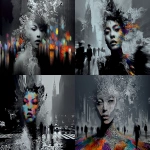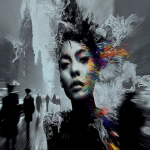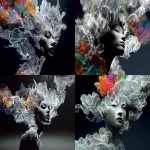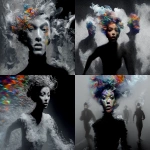Explore the Best AI Image Gallery

Reimagining Graphic Design Through AI Innovations
In recent years, artificial intelligence (AI) has distinctly influenced various fields, and graphic design is no exception. The integration of AI technologies into the design process not only enhances creativity but also streamlines workflow, allowing designers to focus more on ideation and less on repetitive tasks. This blog post delves into the implications of AI in graphic design, examining its benefits, potential hazards, and the trends that may shape the future of this vibrant industry.
The Transformative Power of AI in Graphic Design
AI-driven tools have become essential in assisting graphic designers in generating creative assets quickly and efficiently. Some notable applications include:
- Automated Design Creation: AI algorithms can generate design layouts, logos, and other visual elements based on input parameters. Tools like Canva and Adobe Spark utilize AI capabilities to suggest design elements that match users' preferences.
- Image Recognition and Analysis: AI technologies can interpret images, allowing designers to create contextually relevant graphics. This capability enables designers to produce visuals that resonate more with the intended audience.
- Personalization: AI can analyze user data to create personalized graphics for target audiences, ensuring that the design speaks directly to individual viewers’ preferences.
AI Enhancing the Creative Process
By leveraging AI, graphic designers can explore a plethora of creative pathways. For instance:
- Inspiration Generation: AI can curate inspiration boards by analyzing design trends and styles, providing designers with ideas they might not have considered.
- Exploration of Styles: AI tools can mimic a variety of artistic styles, allowing designers to experiment with and combine influences from different eras or cultures.
- Efficiency and Productivity: Time-consuming tasks—like resizing images or formatting—can be automated, freeing up designers to devote their time to higher-level decision-making and creative exploration.
Ethical Considerations in AI-Driven Design
While the advantages of AI in graphic design are clear, there are ethical considerations that must be addressed:
- Job Displacement: Automation may lead to reduced job opportunities for inexperienced designers, potentially creating a divide between those who can adeptly use AI tools and those who cannot.
- Ownership and Copyright: As AI-generated content becomes more prevalent, the question of ownership arises. If an AI creates a design, who holds the rights? These are pressing questions that the industry must grapple with.
- Bias in Algorithms: AI systems are only as good as the data they are trained on. If that data reflects biases, the designs produced could inadvertently reinforce stereotypes or exclude marginalized voices.
Future Trends of AI in Graphic Design
The graphic design industry is poised for significant transformation as AI technologies advance. Emerging trends to watch for include:
- Collaborative AI: Future tools will likely enable even deeper collaborations between human designers and AI, creating a synergy that amplifies creativity.
- Real-Time Updates: AI may allow designs to instantly adapt to current trends or user feedback, creating dynamic graphics that can change in real-time.
- Integration with Virtual and Augmented Reality: AI-infused graphic design could enhance experiences in VR and AR, giving rise to more immersive and interactive projects.
Conclusion
Overall, AI is reshaping the graphic design landscape, presenting both exciting opportunities and ethical challenges. As designers continue to embrace these powerful tools, it is crucial to remain vigilant about the implications of their use. By striking a balance between innovation and responsibility, the industry can flourish while fostering creativity and inclusivity in design.








](https://images.ai-img.art/thumbnails/150/ff09e32d2be011c0dd785984c5c1e47839ce551a31da1bde242860b30df2aa30.webp)



](https://images.ai-img.art/thumbnails/150/0ba0be922ab76af53f75ab90126ae2b18a600ee3b96941e8ab897a9f10594e5a.webp)


](https://images.ai-img.art/thumbnails/150/7cf5a08238f29c821f52bb4f63db48af0b7f633ff3b9f7253074d78ced9ff6f6.webp)


](https://images.ai-img.art/thumbnails/150/bd056a4718c27444e064198762f8dc8ffa1f74f1afd7dcda8d5cb8b142797d6e.webp)

](https://images.ai-img.art/thumbnails/150/685ae68cfab93a7e59a71206867b060c45bd6fd3cd561c4fe60fca514b09c5f8.webp)

](https://images.ai-img.art/thumbnails/150/847809c77ca9a73b68bc190e6efb06fec87157685a243730d5a66a403b0e6e10.webp)












](https://images.ai-img.art/thumbnails/150/a3ed6513a6661aa3ee46e0c2924d1e8888854e91d8908de39db5590dc41f8d8f.webp)


](https://images.ai-img.art/thumbnails/150/2ebdeb4f7db35100e5be5de9bc3e533a40d14e5feedefd7ffc586524a0f3ba8c.webp)










